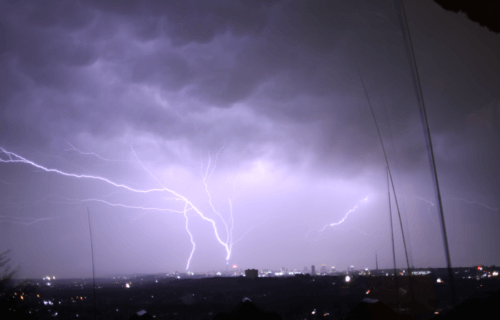JOHANNESBURG, South Africa — Fatal lightning strikes are about as rare as winning the lottery, but a new study finds climate change may be changing that. As the world gathered for the COP26 climate change conference, scientists in South Africa unveiled a tool they say can save lives due to increasingly lethal thunderstorms.
The invention reveals if humans or animals were the victims of a bolt of electricity — based solely upon an analysis of lightning’s “fingerprint” in their skeletons.
“Identifying a fatality caused by lightning strike is usually done though marks left on the skin, or damage to the internal organs – and these tissues don’t survive when bodies decompose,” says lead author Dr. Nicholas Bacci from the University of the Witwatersrand in a release.
“Our work is the first research that identifies unique markers of lightning damage deep within the human skeleton and allows us to recognize lightning when only dry bone survives,” Dr. Bacci continues. “This may allow us to recognize accidental death versus homicide in cases where cause is not apparent, whilst at the same time allowing us to build a more complete picture of the true incidence of lightning fatalities.”
More lightning storms coming?
Estimates show lightning kills around 24,000 people a year. However, researchers say this may increase by around 12 percent in the coming decades. In experiments, the team generated artificial lightning in a laboratory, applying it to bones donated by people who died of natural causes.
“We used equipment to generate high impulse currents in the lab, (up to 10,000 Amps), which mimicked the effect of lightning passing through the skeleton,” says co-author Dr. Hugh Hunt, also from Wits University. “Natural lightning can often have significantly higher peak currents but this allowed us to have much greater control over the experiment than trying to somehow place human tissue in the path of a natural lightning strike.”
Study authors identified a pattern of damage that’s unique to a short duration lightning current.
“Using high-powered microscopy we were able to see that there is a pattern of micro-fracturing within bone caused by the passage of lightning current,” explains senior author Dr. Patrick Randolph-Quinney from Northumbria University.
“This takes the form of cracks which radiate out from the center of bone cells, or which jump irregularly between clusters of cells. The overall pattern of damage looks very different when compared to other high energy trauma, such as that caused by burning in fire,” Randolph-Quinney continues.
“Even though this experiment was conducted under controlled conditions in the lab, we see the same trauma in animals killed by natural lightning. We were able to compare the human results with bone from a poor giraffe killed by lightning – and the pattern of trauma is identical even though the micro-structure of human bone is different from animal bone. This is the smoking gun that we were looking for in forensic lightning pathology.”
Lightning can be hotter than the Sun!
Scientists hope their findings will make the environment safer for those at risk from extreme weather and lightning strikes. Lightning is one of the most spectacular — and destructive — events in nature. They can burn down buildings and spark forest fires.
A single lightning bolt consists of several hundred million volts and travels at a speed of about 270,000 mph. They can also reach a temperatures of 50,000 degrees Fahrenheit — five times hotter than the surface of the Sun!
Some countries are more prone to deadly weather
Study authors note that African countries like Zambia and Uganda have some of the highest lightning fatality rates in the world. In South Africa, more than 250 people die in lightning storms annually. The exact number of deaths globally isn’t clear, due to underreporting. While a lightning burn is easy to spot on the skin or organs, scientists say it’s been harder to identify telltale signs on skeletal remains.
“This is a multi-disciplinary project, which highlights how forensic scientists can work with physicists and engineers to explore a real-world problem, which is implicated in the deaths of many people annually, and especially in countries such as South Africa, Zambia and Uganda,” reports co-author Prof. Ken Nixon.
“At a time when global climate change is driving increases in the number and severity of thunderstorms and lightning strikes, we need more research like this, bringing together different fields with real experience of dealing with lightning,” Nixon adds. “Ultimately our aim at Wits is to make our built environment and countryside safer for those exposed to the lethal effects of lightning energy in South Africa, and to provide life-saving knowledge for those around the globe who are increasingly put in harm’s way of this natural phenomenon.”
The study appears in the journal Forensic Science International: Synergy.
South West News Service writer Mark Waghorn contributed to this report.
